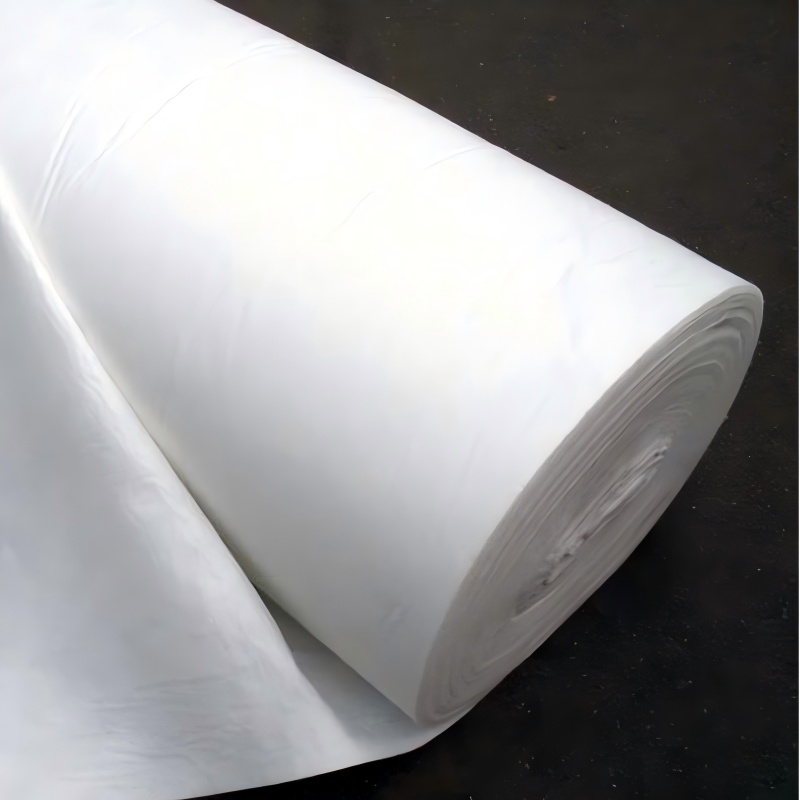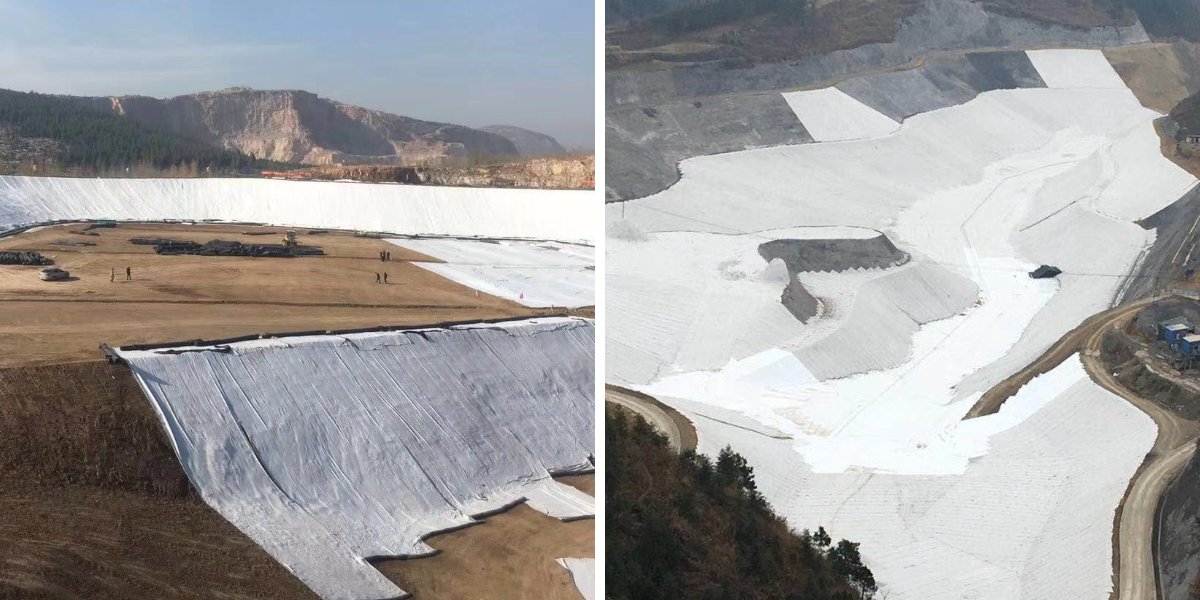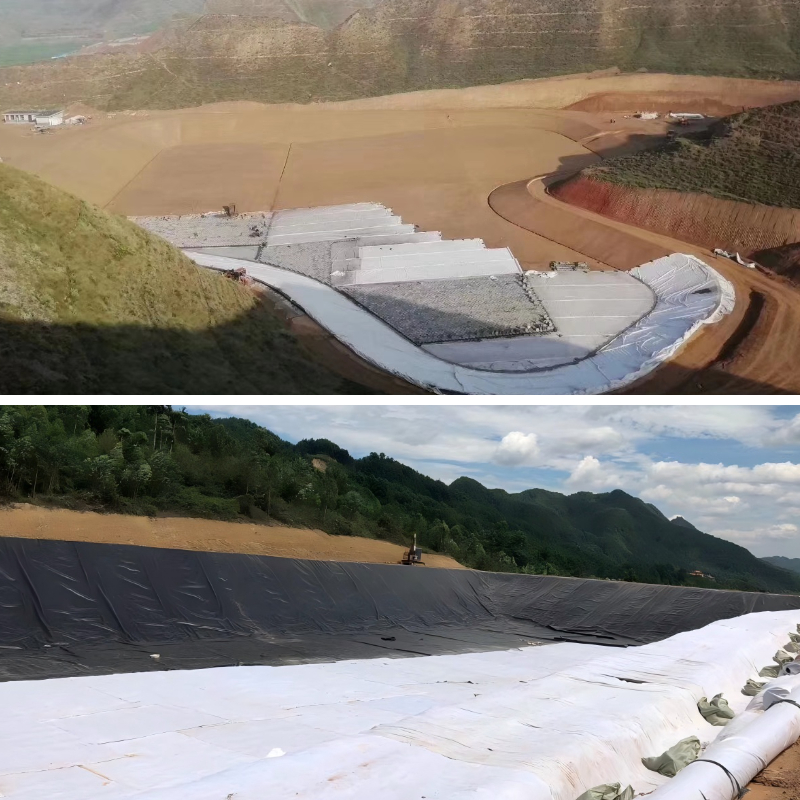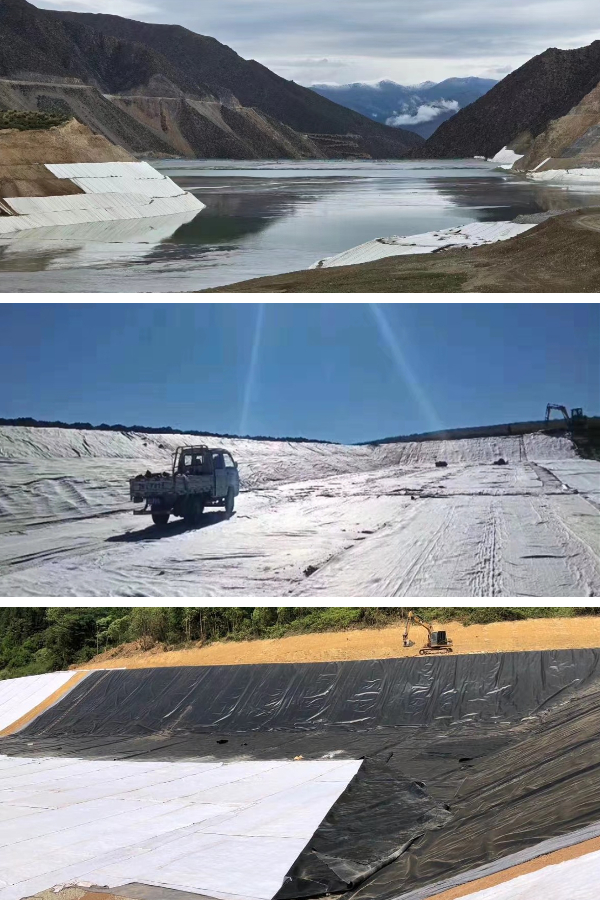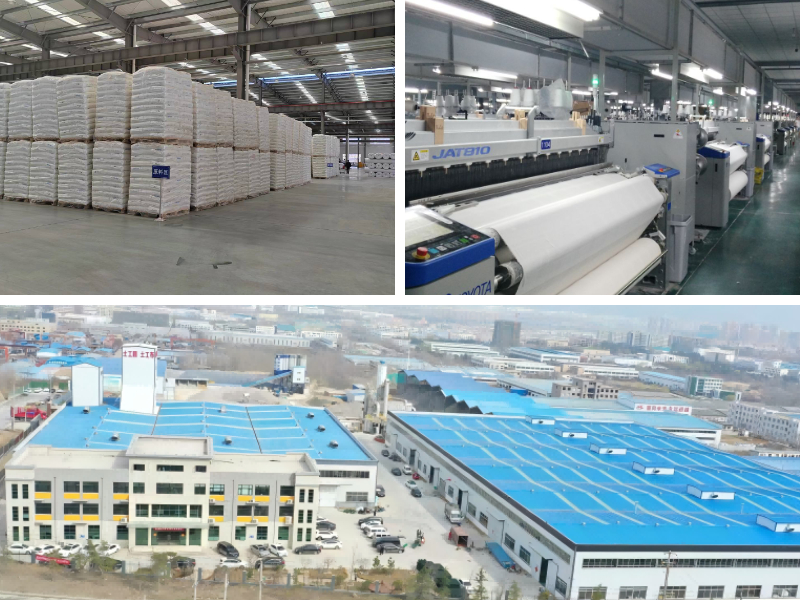Geotextile Fabric for Rip Rap
1. Easy construction and high efficiency: Geotextiles are supplied in the form of rolls, which are lightweight, easy to lay, and can greatly shorten the construction period and reduce labor.
2. Excellent overall performance: As a continuous integral material, it can transmit and distribute stress more evenly, reducing uneven settlement.
3. Easy to control quality: As an industrialized product, its performance indicators are stable and its quality is far superior to natural materials such as sand and gravel selected on site.
4. Reduce engineering costs: It can usually replace traditional structures such as sand and gravel filters and drainage ditches, saving material and transportation costs, and reducing land occupation.
5. Corrosion resistance and resistance to biological damage: Synthetic fiber materials are not easily decomposed, moldy, or invaded by insects and ants, making them suitable for long-term use in various harsh environments.
Product Introduction:
Geotextile Fabric for Rip Rap is a permeable planar structural material made from synthetic fibers (such as polypropylene, polyester, polyethylene, etc.) or natural fibers (such as linen, cotton fibers, which are now less commonly used because synthetic fibers are more weather resistant) through processes such as needle punching, weaving, heat bonding, and hydroneedling. The finished product is mostly in the form of a roll, with a conventional width of 4-6 meters (up to 9 meters for special customization), a length of 50-100 meters, and a unit area mass (gram weight) covering 100-1000g/m ². The specifications can be adjusted according to engineering needs.
Core Features
The widespread application of geotextiles stems from their multidimensional material properties, which enable them to meet the stringent requirements of different engineering scenarios. Specifically, this can be explored in terms of mechanical properties, chemical stability, and construction adaptability
1. Excellent mechanical properties, suitable for complex stress environments
Geotextiles can maintain stable mechanical properties in both dry and wet states: firstly, they have high tensile strength, and the molecular structure of synthetic fibers makes them highly resistant to fracture. For example, the longitudinal tensile strength of polypropylene geotextiles can reach 20-50kN/m, which can withstand the tensile force generated by roadbed settlement and soil displacement, avoiding self fracture; Secondly, the elongation rate is moderate, with a fracture elongation rate usually between 10% and 30%. It will not crack under stress due to being too brittle, nor will it deform excessively due to being too soft, and can cooperate with soil deformation; Thirdly, it has good puncture resistance. The dense fiber structure formed by needle punching or thermal bonding process can resist the puncture of crushed stones and sharp debris in engineering, avoiding the overall function being affected by local damage. It is especially suitable for scenarios with sharp objects such as landfills and roadbeds.
2. Strong chemical stability, achieving long-lasting durability
Engineering materials need to be exposed to soil, water bodies, light and other environments for a long time. The chemical stability of geotextiles allows their service life to reach 10-50 years (depending on the type of material and environmental differences). Firstly, they have outstanding corrosion resistance and strong tolerance to acid, alkali and salt environments. For example, in coastal embankments (saline water bodies) and chemical wastewater treatment tanks (acidic/alkaline wastewater), they will not degrade or become brittle due to chemical erosion; Secondly, it is resistant to microorganisms and insect infestations. Synthetic fibers do not possess the "nutritional value" of natural fibers, and will not be decomposed by microorganisms in the soil, nor will they attract insects to eat, thus avoiding the problem of natural fabrics easily rotting in underground environments; Finally, the aging resistance is good. Some geotextiles will be added with anti ultraviolet agents and antioxidants, which can resist the ultraviolet radiation in outdoor projects and slow down the aging speed of materials. For example, geotextiles for road maintenance can still maintain their effective performance for 3-5 years after long-term exposure to the sun.
3. Controllable permeability, accurately matching engineering requirements
Permeability is one of the core functions of geotextiles, which is controlled by the porosity between fibers, rather than being "completely permeable" or "completely impermeable". On the one hand, the filtration accuracy is controllable. According to engineering requirements, the equivalent pore size of geotextiles can be adjusted to 0.02-0.5mm. For example, in the filter layer of hydraulic engineering, it can allow water to pass through while blocking soil particles (such as sand and soil particles), avoiding structural instability caused by soil loss; On the other hand, the drainage efficiency is stable, and its permeability (the amount of water passing through a unit area per unit time) is much higher than that of ordinary soil. For example, laying geotextiles in roadbeds can quickly drain accumulated water inside the roadbed, reduce pore water pressure, and avoid roadbed softening and settlement.
4. Lightweight and convenient construction, reducing project costs
Compared to traditional engineering materials such as masonry and concrete, geotextile has significant lightweight characteristics: the weight of a single roll of geotextile is usually 50-200kg, and it can be transported without the need for large machinery, manual labor, or small equipment; The laying process is simple, without the need for complex splicing techniques (which can be achieved through hot welding and stitching), and can adapt to irregular engineering interfaces (such as curved embankments and sloping roadbeds) without cutting too much waste; In addition, the flexibility of geotextile enables it to closely adhere to the surface of the soil, avoiding functional failure caused by interface gaps, and shortening the construction period - taking highway subgrade laying as an example, the use of geotextile can shorten the construction time of traditional filter layers by more than 30%.
5. Diversity of specifications, covering all scenario requirements
To meet the functional requirements of different projects, the specification design of geotextiles is extremely rich: in terms of weight, lightweight geotextiles ranging from 100-300g/m ² are suitable for filtration and isolation scenarios (such as filter layers in agricultural water conservancy), while heavy-duty geotextiles ranging from 300-1000g/m ² are suitable for reinforcement and protection scenarios (such as anti-seepage protection layers in landfills); From the perspective of process types, needle punched geotextiles have high porosity and good permeability, making them suitable for filtering and drainage; Woven geotextile has high tensile strength and stable structure, suitable for reinforcement and strengthening; Hot bonded geotextile has a smooth surface and strong puncture resistance, suitable for protective scenarios; In terms of width, the conventional 4-6 meter width can reduce joint seams and lower leakage risks, while the specially customized 9-meter width is suitable for large-scale water conservancy projects (such as reservoir embankments), further improving construction efficiency.
Product Parameters:
project | metric | ||||||||||
Nominal strength/(kN/m) | |||||||||||
6 | 9 | 12 | 18 | 24 | 30 | 36 | 48 | 54 | |||
1 | Longitudinal and transverse tensile strength / (kN/m) ≥ | 6 | 9 | 12 | 18 | 24 | 30 | 36 | 48 | 54 | |
2 | Maximum elongation at maximum load in longitudinal and transverse directions/% | 30~80 | |||||||||
3 | CBR top penetration strength /kN ≥ | 0.9 | 1.6 | 1.9 | 2.9 | 3.9 | 5.3 | 6.4 | 7.9 | 8.5 | |
4 | Longitudinal and transverse tearing strength /kN | 0.15 | 0.22 | 0.29 | 0.43 | 0.57 | 0.71 | 0.83 | 1.1 | 1.25 | |
5 | Equivalent aperture O.90(O95)/mm | 0.05~0.30 | |||||||||
6 | Vertical permeability coefficient/(cm/s) | K× (10-¹~10-), where K=1.0~9.9 | |||||||||
7 | Width deviation rate /% ≥ | -0.5 | |||||||||
8 | Unit area mass deviation rate /% ≥ | -5 | |||||||||
9 | Thickness deviation rate /% ≥ | -10 | |||||||||
10 | Thickness coefficient of variation (CV)/% ≤ | 10 | |||||||||
11 | Dynamic perforation | Puncture hole diameter/mm ≤ | 37 | 33 | 27 | 20 | 17 | 14 | 11 | 9 | 7 |
12 | Longitudinal and transverse fracture strength (grab method)/kN ≥ | 0.3 | 0.5 | 0.7 | 1.1 | 1.4 | 1.9 | 2.4 | 3 | 3.5 | |
13 | Ultraviolet resistance (Xenon arc lamp method) | Longitudinal and transverse strength retention rate% ≥ | 70 | ||||||||
14 | Ultraviolet resistance (fluorescence UV lamp method) | Longitudinal and transverse strength retention rate% ≥ | 80 | ||||||||
Product Applications:
1. In the field of transportation infrastructure
In transportation engineering, geotextiles are mainly used to solve problems such as roadbed settlement, pavement reflection cracks, and slope protection. The core application scenarios include:
Highway/railway subgrade: laying needle punched geotextile between subgrade filling and roadbed soil to achieve soil isolation and avoid the decrease in subgrade strength caused by the mixing of different particle soils; At the same time, the filtering effect of geotextile can prevent soil erosion caused by rainwater erosion, while the drainage function accelerates the discharge of accumulated water inside the roadbed, reduces pore water pressure, and avoids roadbed softening and settlement. For soft soil foundation sections, woven geotextiles can be laid as reinforcement layers to enhance the bearing capacity of the roadbed and reduce post construction settlement (such as in the construction of highways in soft soil areas along the southeast coast of China, geotextile reinforced roadbeds can control settlement within 5cm).
Road maintenance and repair: In the renovation of old road surfaces, laying geotextile (or geogrid composite fabric) between the asphalt surface layer and the base layer can reduce the upward reflection of base cracks to the surface layer (i.e. "reflection cracks"), and extend the service life of new road surfaces; In temporary construction access roads, laying heavy geotextiles can enhance the bearing capacity of the road, avoid damage caused by vehicle crushing, and protect the original ground soil. After construction, the geotextiles can be recycled and reused.
Bridge and tunnel engineering: Laying geotextile in the backfill soil behind the bridge abutment can reduce the settlement difference between the abutment and the roadbed (the "bridgehead jumping" problem) and improve driving comfort; Laying geotextile behind the tunnel lining can serve as a drainage layer, directing water seepage from the lining into drainage pipes to prevent water accumulation inside the tunnel and protect the lining structure from water seepage erosion.
2. Water conservancy and hydropower engineering
In hydraulic engineering, the filtering, drainage, and protective functions of geotextiles are particularly critical, mainly used for:
Reservoir/embankment construction: Laying geotextile (often combined with geomembrane) on the upstream slope of the embankment as an anti-seepage protective layer to prevent soil loss caused by wave erosion; Laying vertical or horizontal geotextile drainage layers inside the dam can dissipate the pore water pressure in the soil and avoid piping and landslides caused by excessive seepage pressure in the dam (such as the extensive use of needle punched geotextile as a drainage filter layer in the dam reinforcement project of the Three Gorges Reservoir in China); Laying geotextile on the upper and lower layers of the anti-seepage membrane of the dam can protect the anti-seepage membrane from being pierced by sharp stones, filter out seepage water, and prevent soil loss under the membrane.
River/channel management: In river slope management, geotextile is laid and then covered with soil and vegetation to form an ecological protection system of "geotextile+vegetation". This can not only reinforce the slope, prevent river bank collapse caused by water flow erosion, but also improve the ecological environment of the river; In irrigation channels, geotextile can be used as a filter layer, laid at the bottom and slopes of the channel, to avoid channel leakage (reduce water waste), and prevent soil particles from flowing away with water flow, thus extending the service life of the channel.
Port and Coastal Engineering: In the construction of breakwaters at port terminals, heavy geotextiles (such as woven geotextiles) are laid to resist wave impacts and protect the embankment filling materials; In coastal protection engineering, geotextile can be combined with sandbags and stones to form a flexible protective structure that adapts to soil deformation caused by tidal changes on the coast and avoids cracking of rigid revetments (such as concrete revetments) due to wave impact.
3. Environmental Protection Engineering
Environmental engineering has extremely high requirements for material corrosion resistance, leakage resistance, and environmental friendliness. Geotextile is one of the core materials, mainly used for:
Landfill site: In the anti-seepage system of a landfill site, geotextile plays a key role - laying geotextile on top of high-density polyethylene (HDPE) anti-seepage film as a protective layer to prevent sharp debris (such as metal and glass) from puncturing the anti-seepage film; Lay geotextile underneath the anti-seepage membrane as a filter layer to filter the groundwater at the bottom of the landfill site, avoiding soil particles from blocking the seams of the anti-seepage membrane and protecting the membrane body from sharp objects on the foundation; In addition, geotextile can be used as a filter layer in the leachate collection system of landfills to filter out garbage debris in the leachate and prevent blockage of the collection pipeline.
Wastewater treatment and solid waste disposal: Laying geotextiles on the bottom and walls of industrial wastewater treatment tanks can enhance the anti-seepage properties of the tank structure and protect the anti-seepage layer from corrosion by wastewater; Laying geotextile as a drainage filter layer in tailings ponds (mining solid waste accumulation sites) can accelerate the discharge of water from tailings water, promote tailings consolidation, reduce the risk of tailings dam failure, and prevent tailings particles from flowing away with water and polluting surrounding soil and water bodies.
Soil remediation engineering: In the remediation of heavy metal contaminated soil, laying geotextile can serve as an isolation layer to block the contact between contaminated soil and uncontaminated soil, avoiding the spread of pollution; At the same time, the permeability of geotextiles can be combined with the penetration of remediation agents (such as activated carbon and microbial agents) to improve soil remediation efficiency.
4. Construction and Municipal Engineering
In construction and municipal engineering, geotextiles are mainly used for ground treatment, underground waterproofing, greening projects, and other scenarios
Building foundation and foundation pit: In the deep foundation pit support of high-rise buildings, laying geotextile as a drainage layer can accelerate the discharge of groundwater in the surrounding soil of the foundation pit, reduce the water level of the foundation pit, and avoid foundation pit collapse; In soft foundation treatment (such as fill foundation), laying geotextile as a reinforcement layer can enhance the overall strength of the foundation, reduce uneven settlement of the foundation, and avoid cracking of building walls.
Underground pipe gallery and pipeline engineering: laying geotextile on the outside of the underground comprehensive pipe gallery can serve as a protective layer to protect the pipe gallery structure from sharp objects in the surrounding soil, while filtering groundwater and avoiding leakage at the pipe gallery interface; In the laying of water supply and drainage pipelines, adding geotextile to the backfill soil around the pipeline can reduce the pressure of soil on the pipeline, prevent pipeline corrosion, and extend the service life of the pipeline.
Municipal greening and landscape engineering: In roof greening and vertical greening projects, geotextile is laid as a filtering layer to separate planting soil and drainage layer, avoiding planting soil particles blocking drainage holes and preventing plant roots from penetrating the drainage layer, protecting the roof or wall structure; In the construction of urban artificial lakes and landscape rivers, geotextiles can be used as anti-seepage protective layers, combined with geomembranes, to prevent lake water leakage and protect the anti-seepage membrane from being damaged by stones and plant roots at the bottom of the lake.
5. Agriculture and Ecological Engineering
In the fields of agriculture and ecology, geotextiles are mainly used for water-saving irrigation, soil and water conservation, ecological restoration and other scenarios:
Agricultural water conservation and soil and water conservation: Laying geotextiles in irrigation channels can reduce channel leakage and improve water resource utilization (such as in irrigation channels in arid northwest regions, the use of geotextiles can reduce leakage by more than 80%); Laying geotextile along contour lines in terraced fields and sloping fields can slow down the speed of rainwater erosion, prevent soil loss, while maintaining soil moisture and increasing crop yields.
Ecological restoration and soil and water conservation: In mining greening and barren mountain management projects, laying geotextiles (often combined with ecological blankets and grass seeds) can fix the slope soil, prevent soil erosion, and provide a stable growth environment for grass seed germination, accelerating vegetation recovery; In the construction of river ecological buffer zones, geotextiles can be used as base materials, combined with aquatic plant planting, to build waterfront ecosystems, purify water quality, and protect aquatic habitats.
In addition, geotextiles are also used in special fields such as military engineering (such as temporary flood embankments, field works), aerospace (such as airport runway base reinforcement), etc. Their multifunctional and highly adaptable characteristics continue to expand their application boundaries, becoming an indispensable and important component of modern engineering material systems.



